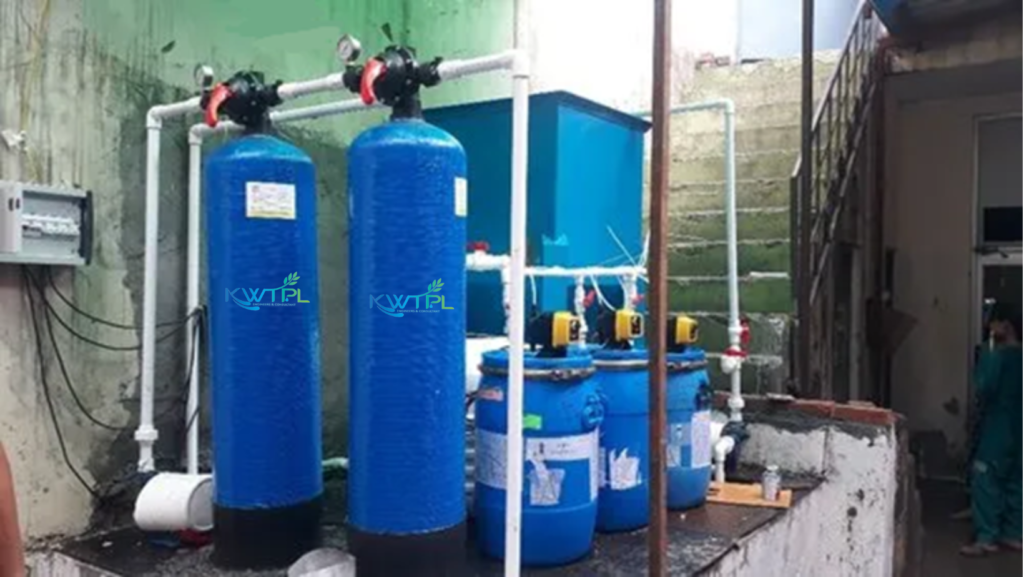What is Small ETP Plant? Explain Types & its Importance.

Small ETP Plant | Mini Effluent Treatment Plant
Small ETP Plant, also known as a Small Effluent Treatment Plant, is an essential system used in industries to treat and purify wastewater before it is released into the environment. This type of plant is designed to handle smaller volumes of wastewater generated by businesses or residential communities.
A Small ETP Plant consists of various processes that effectively remove contaminants from the wastewater, making it safe for discharge or reuse. These processes may include physical, chemical, and biological treatments, depending on the specific requirements of the wastewater.
Common components of an ETP plant, whether small or large, may include:
- Screening and Pre-treatment: Removal of larger solids and preliminary treatment to protect downstream processes.
- Primary Treatment: Physical processes such as sedimentation to separate settleable solids.
- Secondary Treatment: Biological processes that use microorganisms to break down organic pollutants.
- Tertiary Treatment: Additional processes to further polish the effluent and remove remaining impurities.
- Disinfection: Treatment to kill or inactivate harmful microorganisms.
- Sludge Management: Handling and disposal of the sludge generated during the treatment process.
Importance of Small ETP Plant
Environmental Protection: This helps prevent the contamination of rivers, lakes, and groundwater, preserving ecosystems and biodiversity.
Regulatory Compliance: Small ETP plants enable industries to comply with these regulations, avoiding legal issues and potential fines associated with non-compliance.
Public Health and Safety: ETPs reduces the risk of harmful pollutants entering the environment, safeguarding public health, and ensuring the safety of communities residing near industrial facilities.
Water Resource Conservation: Small ETPs facilitate the treatment and potential reuse of water within industrial processes, contributing to water conservation efforts and reducing the demand for freshwater resources.
Risk Mitigation: ETPs help mitigate the environmental and reputational risks associated with improper disposal of industrial effluents. By treating wastewater, industries reduce the likelihood of accidental spills and environmental incidents.
Adaptability to Small Industries: Small ETP plants are designing to cater to the needs of smaller industrial operations, making wastewater treatment accessible and feasible for a wide range of industries, including those with limited space and resources.
Comprehensive Treatment: Small ETPs can incorporate various treatment stages, ensuring the comprehensive removal of pollutants and contaminants from industrial effluents.
Types of Small ETP Plants
1. Physical ETP: This type of plant focuses on removing physical impurities from wastewater through processes like screening, sedimentation, and filtration.
2. Chemical ETP: This plant uses chemicals to treat wastewater by neutralizing harmful substances & facilitating precipitation or coagulation for easy removal.
3. Biological ETP: These plants utilize microorganisms to break down organic matter present in wastewater and convert it into harmless byproducts like carbon dioxide and water.
4. Sequential Batch Reactor (SBR): SBR plants operate in a batch mode, where different steps like aeration, settling, decanting, and sludge removal occur sequentially in the same tank.
5. Membrane Bioreactor (MBR): MBR systems combine biological treatment with membrane filtration technology to achieve efficient solid-liquid separation while maintaining high-quality treated water.
6. Reverse Osmosis (RO): RO plants employ semi-permeable membranes that remove dissolved solids from wastewater by applying pressure greater than osmotic pressure.
Small Effluent Treatment Plant Manufacturer
At the KWTPL Research we understand the needs of our customers and provide a compact effluent treatment plant as a solution.
Additionally, the Small ETP Plant operated at full capacity to meet user demand. Because of its lower size, performance is unaffecting. Smaller ETPs range from 5 to 50 KLD, depending on the needs of the user.
It functions well and may be set up to reduce BOD, remove solids, remove ammonia and nitrogen, and reduce phosphorus. Additionally, a packaged ETP plant was constructed to produce wastewater recycling and chemical and biological treatment.
Kelvin Water Technologies provide small Effluent Treatment Plant for handling small industries. These tiny ETP units can be installing anywhere, such as in the basement, on top of a building, or anywhere makes the most structural sense for your home.
Conclusion
In today’s world, where environmental concerns are at the forefront of our minds, it is crucial for businesses to take responsibility for their wastewater management. Small ETP plants provide a practical and efficient solution to treat industrial effluents and ensure compliance with regulatory standards.
Small ETP plants offer a range of benefits, including cost-effectiveness, space efficiency, and minimal maintenance requirements. They not only help in reducing pollution but also contribute towards water conservation by enabling the reuse of treated water in various applications.
Choosing the right small ETP plant for your business requires careful consideration of factors such as effluent characteristics, treatment capacity, and budget. It is essential to consult with experts in wastewater management who can assess your specific needs and recommend the most suitable system.